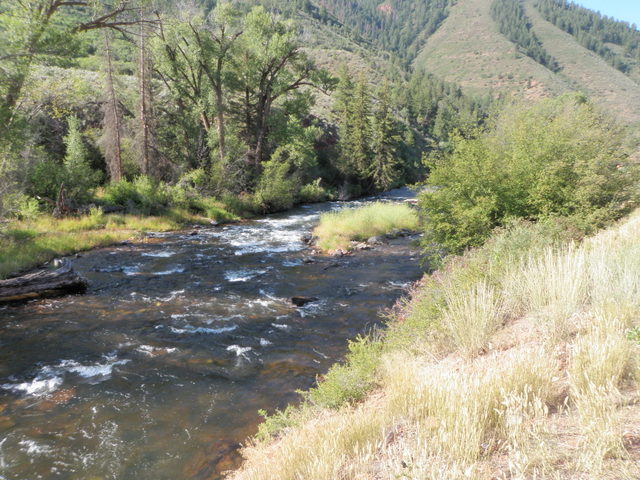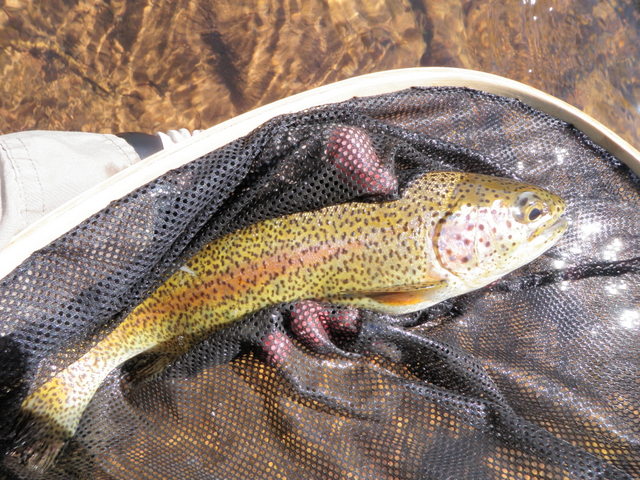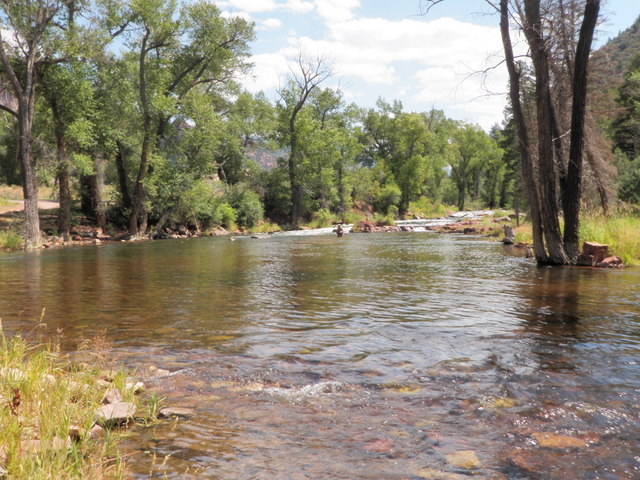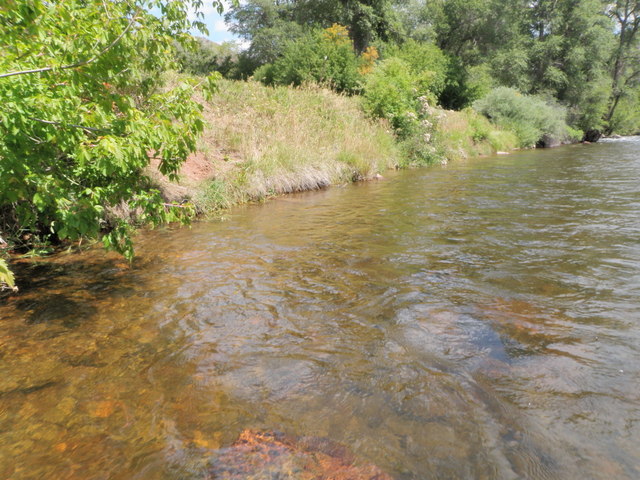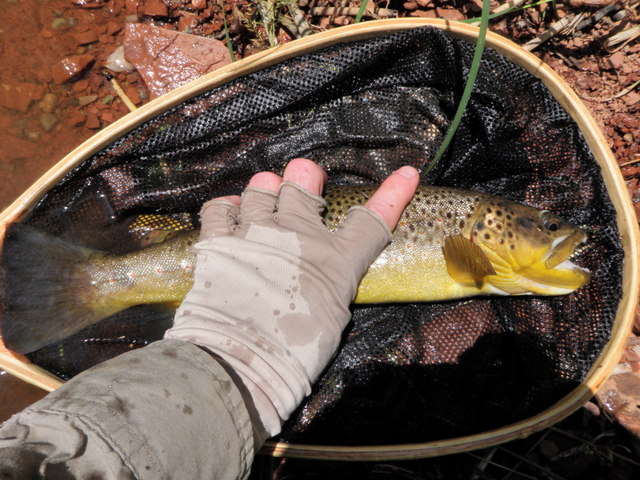Time: 9:30AM – 4:00PM
Location: MM4 in morning and MM7 downstream from large White River National Forest sign in afternoon
Fish Landed: 9
Frying Pan River 08/16/2013 Photo Album
The Department of Water Resources chart for the Frying Pan River near Reudi displayed a straight line of 220 cfs for over a week and this stability generally bodes well for excellent fishing. I’d experienced a nice day on Thursday, but could I repeat that experience on my last fishing day before returning to Denver for the weekend? Also, should I fish the water between MM10 and the dam or drive downstream further in hopes of finding a heavier green drake and PMD hatch as they generally progress upstream? These were questions I pondered as I packed up my tent and camping gear on Friday morning and prepared for a day of fishing. I retrieved my large fly boxes from my fishing bag and took an inventory of green drakes and added a few more to my frontpack foam patch.
By 9AM I was packed up and ready to begin my day of fishing. The sky was once again a brilliant blue with no clouds in sight and the temperature was already in the upper 60’s. Dave Loch described some nice water near Strawberry Rock access on the lower river, and I’d never spent much time in that area, so I decided to sample it on Friday morning. I found a tiny pullout just below the MM4 sign and prepared to fish. My rod was already put together from the previous evening so all I had to do was remove the caddis and tie on a Chernobyl ant and beadhead hares ear.
The next challenge was finding a path to the river as the bank was extremely steep and some dense bushes separated the road and river. After a short walk I found a faint trail and carefully descended to the river. I wanted to access an area twenty yards downstream where the river fanned out before plunging over some rocks, but the only way to get there was to wade along the bank and through some fairly attractive pockets. I made some downstream casts to the pockets before disturbing them, but I wasn’t very optimistic that I hadn’t spooked the fish by being in their upstream field of view.
When I got to the shallower area I moved to the middle of the river and then toward the south or east bank so I wasn’t looking into the morning sun. I began casting back toward the middle and roadside bank and after a half hour of fishing landed a 10 inch brown that attacked the Chernobyl ant. Prior to this I foul hooked two or three fish that apparently refused the Chernobyl and I snagged them with the trailing nymph. The hares ear once again wasn’t producing any results so I switched it for a salvation nymph.
As I moved upstream along the right bank I came upon a deep narrow slot along a red ledge rock and as my flies drifted tight to the rock wall the Chernobyl dipped and I set the hook and landed a nice 13 inch rainbow and photographed it. Next some fast water forced me back to the bank closer to the road and in a nice deep pool behind a current break I landed two very nice rainbows on the Chernobyl ant. The first fish was 15 inches and the second appeared to be 16 or 17 inches relative to the opening on my net.
I was perplexed by the fact that I was catching only rainbows and attributed it to the fact that I was fishing two attractors, so I once again exchanged the salvation nymph for the hares ear and this resulted in two browns under 12 inches. Perhaps there was something to my theory of attractor vs flies with a more natural appearance. By now it was 11:40AM and I was positioned directly beneath the Santa Fe, so I scaled the very steep bank and sat on the top rim to eat my lunch.
After lunch I resumed from my morning end point and proceeded around a bend and then through an area with a cluster of dead falls and fast water and then approached a huge wide pool. Another fisherman was stationed next to the attractive run at the head of the pool so I climbed out of the river and went around the pool. On the way I passed a host of fishermen eating their lunch or preparing to fish. The noon sun was now directly overhead and pounding down on everything below, and Friday was shaping up to be considerably warmer than Thursday.
Above the large pool I encountered another inviting deep pool and as I drifted my Chernobyl and nymph combination I spotted a rainbow holding 4-5 feet below the surface. The fish showed interest several times in the Chernobyl by elevating closer to the surface and twitching its tail fin, but no take was forthcoming. I didn’t want to fixate on this fish as it was quite deep in the water column, so I moved along and fished some narrow slots next to the bank, but again I was not rewarded for my efforts.
By 1PM it was quite warm and no clouds were in the sky so I decided to move further upstream in hopes of a higher likelihood of encountering a hatch. I drove to MM7 and parked in a pullout that contained a large White River National Forest sign. I grabbed my gear and walked down the road to a point just before some private water and made some half hearted casts with the Chernobyl and nymph combination. This clearly wasn’t working so I resolved to change things up and removed the two flies and tied on a parachute green drake thinking that I was further upstream and perhaps close to where the drakes were still hatching or maybe in an area where the green drake hatch was a recent event. I selected the size 14 green drake with an olive hackle, but the hackle had become deformed and pressed back so that no fibers extended beyond the eye of the hook. The fly didn’t ride correctly on the surface so I clipped it off and replaced with a size 12 version and this resulted in a foul hooked brown.
I continued working up the left side of the river and began to see a few sporadic rises. This perplexed me as I didn’t see any insects riding on the surface or in the air above the river, so I paused to seine the water with my net, but this didn’t clarify the situation in any way. Much to my chagrin the mystery hatch intensified and the rises became more frequent. At a loss for an answer to what the fish were feeding on, I tied some tippet to the bend of the green drake and added a parachute ant with an orange wing post. I cast these two flies above the closest fish and most frequent riser and watched in dismay as the brown rose and pressed its nose against my ant without eating it.
As this transpired another fish rose five feet above the lower one so I switched focus and lofted a curve cast above the new feeder. The flies landed so that the parachute ant led the green drake and a thirteen inch brown drifted up and consumed the ant! I was pretty excited to land this fish under very difficult conditions. Unfortunately the ant did not produce more action and the green drake was useless, so I clipped them off and tied on a rusty spinner from my Pennsylvania fly box but then added the ant back below the spinner. I attempted to catch the lower fish again with this new combination and actually pricked the fussy guy with the spinner.
This was enough frustration from this area, so I moved on upstream and began to see emerging PMD’s, but quite sparse so I switched to the light gray comparadun AKA money fly. I landed a medium size brown along the left side, but the intensity of the hatch increased although still not as strong as Thursday. I surveyed the river which was actually a wide riffle of moderate depth and observed more rises along the right side so I waded to the middle and then moved below the more dense cluster of rises. Unfortunately an hour of frustration followed as the regular risers showed no interest in my usually effective light gray comparadun.
I began a series of fly changes beginning with a yellow body comparadun and then a very light yellow sulfur version but still no luck. Four fish above me rose regularly but they ignored all my offerings. I finally conceded to these picky trout and moved back to the left bank and tied the proven light gray comparadun back on. The natural flies on the water during this hour of frustration looked smaller than my imitation so I probably need to tie some size 18’s before I return to the Frying Pan River. I now realized I’d gone fishless through the best hatch of the day, so I moved up along the left bank and spotted sporadic rises to stragglers as the hatch now dwindled.
I was focused on an upstream rise when I spotted a subtle move and sip out of the corner of my eye in front of a tree branch no more than eight feet above me and to my left. I backcast and hooked a short cast above the rise and a large brown slowly appeared and sipped in my fly. This is the kind of visual action that keeps me addicted to this sport. After a strong fight and dogged head shaking I landed the 14-15 inch brown and brought my count on the day to nine.
Once again I moved upstream closer to a spot where I spotted a rise and as I prospected the general area I spied a decent rainbow holding very tight to some dead branches along the bank. I attempted to hook some casts to the rainbow, but could not get above the fish due to the branches and eventually shot a cast to far and wrapped the fly and line. This forced me to wade to my fly to retrieve it and in the process I disturbed the fish.
Another move upstream brought me to a sitiation similar to the last fish landed as I noticed a nice brown just above a protruding branch. This target however would not take my comparadun although it inspected and refused it. Next I tried a parachute ant with a yellow wing post and this provoked two or three refusals where the fish put its nose against the ant. I opened my patch and spotted the predator, a new fly I’d tied at the very end of the tying season. I only made two and it looked like a large realistic foam beetle. It went on to the end of my line and I plopped it above the brown, and the fish darted up and gobbled the foam creation. I set the hook and managed to prick the fish and then uttered a few expletives.
Next came a nice deep area below some dead logs and I spotted another brown lurking in the partial shadows. The predator was still on my line but I added a beadhead pheasant tail and launched a few casts in the vicinity of the brown and on the third or fourth drift I saw a bulge and set the hook. The fish took off instantly and I thought I had fooled the brown in the shadows, but quickly discovered the fish was foul hooked in the cheek area by the predator, so I either experienced a refusal or I was late on the hook set due to the difficult lighting.
At this point my progress was blocked by a jumble of logs so I climbed up to the parking lot and then found a worn path through the woods back down to a long deep pool with a vertical rock wall on the south side of the river. I covered this stretch to no avail as the water now appeared to be dead with no insects, not even stragglers present. Shortly after 4PM I reeled up my flies and called it quits with a long drive back to Denver ahead of me.
The temperature on the dashboard in the Santa Fe was in the mid-80’s as I began to drive back along the Frying Pan River to Basalt. I probably should have spent the day or at least the afternoon above MM10 but at least I had the water to myself and did have an hour of hatch action. Unfortunately I couldn’t convert my opportunity as completely as I would have liked.

